Family meals and favorite dishes are powerful: they can engender a feeling of comfort, catalyze memory, and anchor us when we gather.
Inspired by an heirloom Chocolate Sour Cream Pound Cake recipe featured in Catherine Lambrecht’s Road Scholars presentation on family recipes from the Illinois State Fair, Illinois Humanities staff members were invited to share dishes from their own families and the memories they carry. Their stories reveal the power of a simple meal to transport you to a different time or place and bring back vivid memories of time with loved ones.
We hope these recipes and their stories will remind you of a favorite dish, spark conversations with your family and friends, and inspire you to step into the kitchen to enjoy a family favorite or try a new one by our staff.
Have your own family story or recipe to share? We’d love to hear from you! Email us at LetsEat@ILHumanities.org or tag us on social media @ILHumanities #ILHumanities and we may feature your story on the Illinois Humanities blog or social media.
Fairouz AbuGhazaleh, Director of Statewide Programs
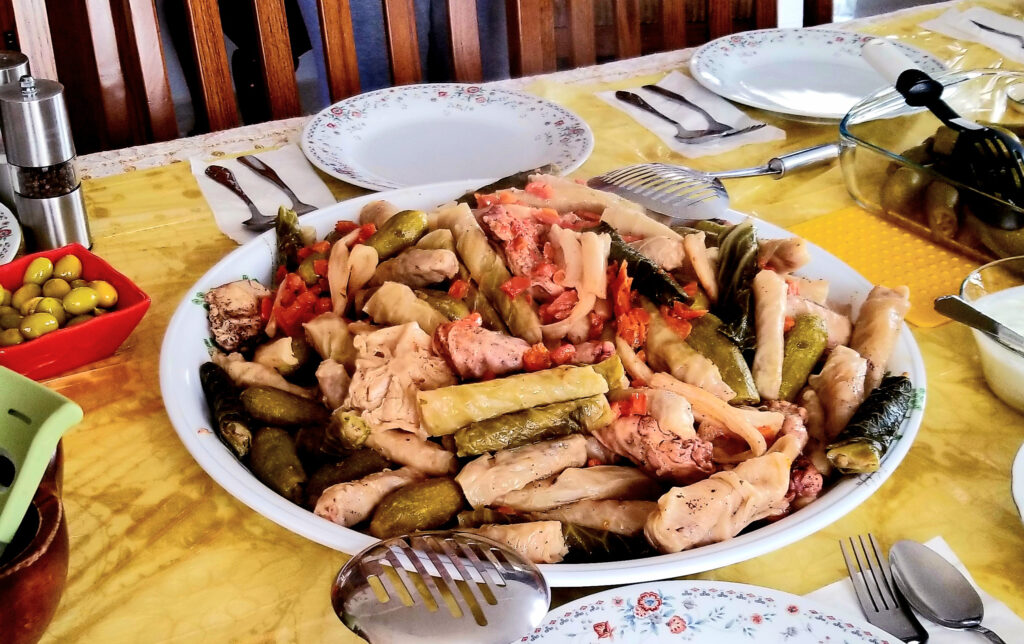
I miss the aroma of my mama’s cooking. How it travels slowly out of the kitchen and awakens my appetite. I especially miss the smells of cabbage leaves stuffed with rice and seasoned beef, topped with garlic cloves and lemon juice all simmering together for hours.
I long for the comfort that food brought, the love it was made with and the people that gathered around it. I long for my family.
Meredith Nnoka, Community Educator
My dad’s parents were Nigerian and Swedish. My dad and his sister were the first Nnokas to come to the U.S. from Nigeria, while my grandmother’s Swedish family immigrated to Connecticut around the time of World War I. My grandmother maintained one tradition from her Swedish relatives: a Swedish smorgasbord on Christmas. Growing up, every year the Swedish-Nigerian branch of the Nnoka family would crowd into Grandma’s apartment in Arlington, Virginia—surrounded by my grandmother’s artifacts from her years in Nigeria (sculptures, books, and various knick-knacks)—and eat the foods of her ancestors, including her family’s delicious Swedish meatballs. Our family’s recipe is over a hundred years old (possibly much older) and is one of our most concrete connections to the “old country” still in existence. My grandmother left me her recipe before she died in 2009, and this year I’ve been working to resurrect and master it in time for Christmas 2022.
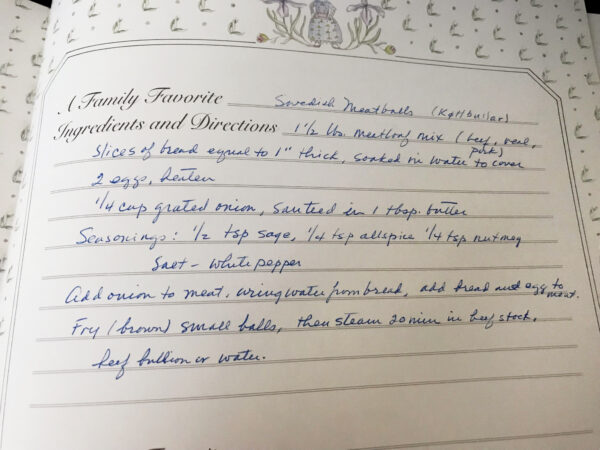
Ingredients
-
- 1⁄2 lb. ground beef
- 1⁄2 lb. ground veal
- 1⁄2 lb. ground pork
- 5 slices of bread equal to 1” thick
- 2 eggs, beaten
- 1⁄4 cup grated onion
- 1 stick unsalted butter
- 1 tsp sage
- 1⁄4 tsp allspice
- 1⁄4 tsp nutmeg
- Salt
- White pepper
- 3 cups beef stock
- 4 tbsp flour
Directions
-
- Soak bread slices in water to cover. While bread soaks, sauté grated onion in half a stick of butter on low heat until onion is clear.
- In a large bowl, combine beef, veal, and pork. Add onion and seasonings to meat. Add salt and pepper to taste.
- Wring water from bread, then tear into small pieces. Add eggs and bread to meat mixture.
- Combine ingredients until they are distributed evenly throughout the mixture. Separate and shape mixture into small meatballs.
- Fry (brown) meatballs in a pan, then steam in a pot for 20 minutes in beef stock.
- Once meatballs are done cooking, using the drippings from the pan, melt remaining butter, add flour, and whisk together. Add beef stock used for steaming one cup at a time and continue whisking until mixed and smooth. Continue stirring until thickened.
Rebecca Amato, Director of Teaching and Learning

My mother hated to cook, and my father could only heat up Hormel’s corned beef hash in a pan. Still, I grew up a hearty and relatively healthy eater with a powerful and abiding love for pastries. But that’s another story.
There were two things my mom did enjoy cooking, however, and they made her very popular in our temple. The first was potato latkes and the second was her “famous” lox spread. People would ooh and ahh over both asking how she made the latkes so crispy on the outside and fluffy on the inside, how she so thoroughly distributed all the ingredients in the lox spread. As I’ve grown older, I’ve realized that my mother and I shared this in common when it comes to the kitchen: we are good at shortcuts, and we prefer assembling to cooking.
So here are the family secrets: the latkes were basically frozen hash browns mixed with egg, onion and matzoh meal, then fried. Delicious. The lox spread was even simpler: just get your daughter to hand chop green onions, cucumber, and nova lox, then use your powerful arm strength to mix it together with softened cream cheese and a tablespoon of capers. Ta-da! A lox spread to die for and a pretty strong daughter to boot!
Karen Loda, Development Manager
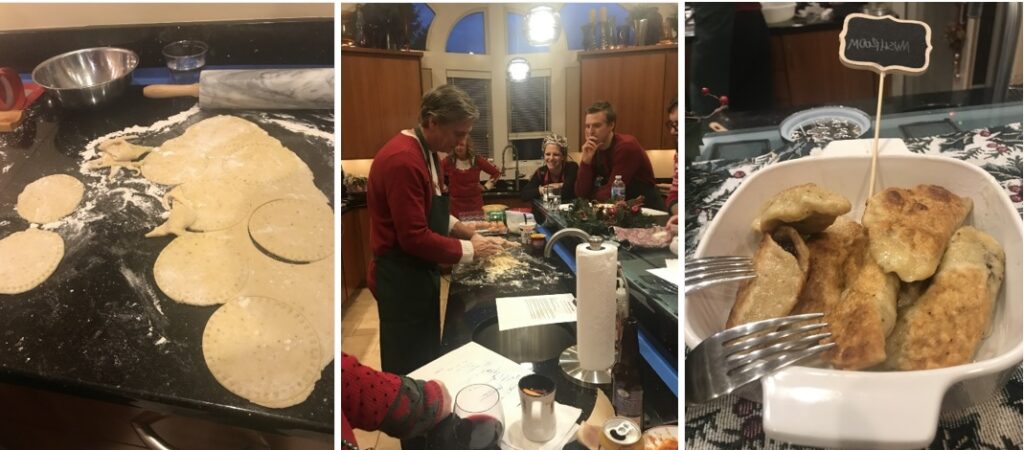
Every Christmas Eve I can remember, there have been delicious, comforting, fried pierogies. Since this side of my family was Catholic, Christmas Eves would traditionally be meatless—hence pierogies. When I was very little, we would all gather at the house of my three great-grand aunties, Blanche, Anne, and Albie, in Brookfield for the holidays and there would be a plethora of Polish food and treats. They were born in the early 1900s to Polish immigrants who had moved to the Pilsen neighborhood of Chicago and were members of the historic St. Adalbert’s church. I remember my aunties as very frugal, having lived through the Depression, yet very generous and always taking care of everyone in the family, especially the young children. They never wrote it down, but my Uncle Paul would watch and write down the ingredients and steps and translated them into a detailed recipe for the family. A few Christmases ago (and with a lot of wine), he taught us all how to make them so this tradition can live on.
Depowski’s Pierogies
Start off by pouring a nice size glass of wine! (While the Aunties did not specifically indicate this, I find it to be a critical first step)
Dough Ingredients
-
- 2 cups all-purpose flour (makes 18-24 pierogies)
- 2 eggs
- 1/3 cup of water
- Salt, pepper, garlic powder to taste (1/2 tsp of each)
- 1tbsp sour cream (the secret ingredient, oh yeah the garlic too!)
Dough Directions
-
- Mound the dough on a board or bowl and make a well in the center. Drop eggs, salt, pepper, garlic powder, and sour cream in the center and begin kneading the flour into the liquid. Continue to add water and knead until dough is firm and well mixed.
- Cover with a warm bowl and let rest for 10 mins. Then divide dough in half and working with half at a time roll out to the desired thickness, 1/8 inch or so.
- Cut 3-4 inch rounds and place a small amount of filling on one side. Moisten the edges with water, fold over and pinch together. The Aunties would then give the edges a little twist.
- Drop stuffed pierogies in salted boiling water 6-12 at a time – depending on pot size – until they float. Remove from boiling water and place in cooking ware with lots of butter until all batches are complete.
- Last step is to fry in hot pans, again with lots of butter, to your desired degree of browned. You will have a little dough leftover, we roll these in our hands and make Paluszki. Cook the same as above.
Fillings
Your choice, however, it is best to make any “cooked” filling ahead of time and make sure it is chilled. This is best for stuffing. Other family favorite fillings include potato, cherry, mushroom, and meat.
Sauerkraut Filling
The aunties would use a combination of jar sauerkraut and any leftover cabbage they had previously frozen. I stick with just using the jar variety of kraut (I don’t like cans). Use about 2 cups per batch. Rinse in cold water and drain. In a large pot melt butter and sauté ½ cup diced onions and chopped garlic to taste (1 tbsp-ish salt and pepper). The aunties also liked to add caraway seeds. Add sauerkraut and fry until softened. Take off the heat and stir in 1 tbsp sour cream. When ready to stuff, I dice the kraut mixture just to make it a little easier to work with.
Tia K. Williams, Digital Communications and Technology Systems Manager
Why Thanksgiving is my favorite holiday…
Back when the majority of my very large family lived in Chicago, my grandmother’s big nine-bedroom house served as the gathering place for the holiday. Cooking was from scratch and started three days prior. On the day of, throughout the day, no less than 100 people made their way to the house to eat, give thanks, and have fun with family. This despite the fact that they may have cooked dinner at their own homes. By the time the day was over and done, there wasn’t a drop of food left. What made this time very special though was not the amazing food both in taste and amount, not the impromptu family reunion it always generated, not the card games, not the lively sports watching, but the prayer and giving of thanks that occurred with everyone present at the time we broke bread. We all gathered in a circle that started in the foyer, went through the main rooms of the first floor, down to the basement, back up around to the second floor and back down to the first to complete the circle. After the prayer led by my grandmother or grandfather, each of us took turns listing what we were thankful for since our last gathering. The big house was the place to be for Thanksgiving. I miss it.
My favorite Thanksgiving dish is my grandmother’s dressing, complete with your choice of gizzard gravy and/or cranberry sauce. However, while I am able to list all the ingredients and give directions on how to put it together, I couldn’t begin to tell you how much to use of most of the seasonings. I watched my grandmother make it for as long as I can remember. I served as her taste tester once I got old enough. That’s how we make it – by taste. So, instead, I will share the recipe we use for banana pudding (from Nabisco’s NILLA Wafers back of the box recipes). By the way, in all the times that we’ve made this dish, we have never used an official double boiler. We use two pots: one on the stove with water inside and the second sits inside it. It is the second pot that is used to make the custard or pudding.
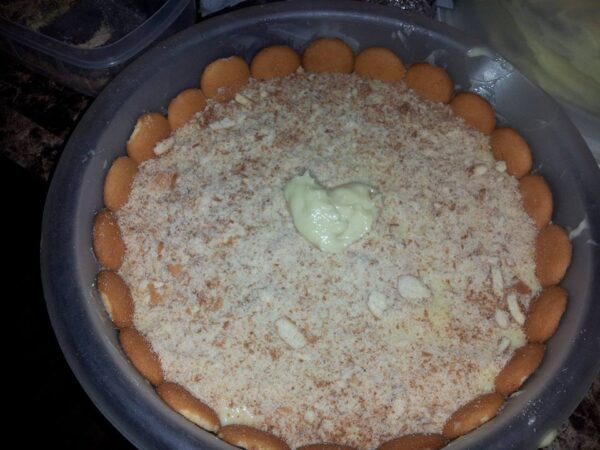
Ingredients
-
- 3/4 cup sugar, divided
- 1/3 cup all-purpose flour
- Dash salt
- 3 eggs, separated
- 2 cups milk
- 1/2 teaspoon vanilla extract
- 45 NILLA Wafers, divided
- 5 ripe bananas, sliced (about 3 1/2 cups), divided
- Additional NILLA Wafers and banana slices, for garnish
Directions
-
- Mix 1/2 cup sugar, flour and salt in top of double boiler. Blend in 3 egg yolks and milk. Cook, uncovered, over boiling water, stirring constantly for 10 to 12 minutes or until thickened. Remove from heat; stir in vanilla.
- Reserve 10 wafers for garnish. Spread small amount of custard on bottom of 1 1/2-quart casserole; cover with a layer of wafers and a layer of sliced bananas. Pour about 1/3 of custard over bananas. Continue to layer wafers, bananas and custard to make a total of 3 layers of each, ending with custard.
- Beat egg whites until soft peaks form; gradually add remaining 1/4 cup sugar and beat until stiff but not dry. Spoon on top of pudding, spreading evenly to cover entire surface and sealing well to edges.
- Bake at 350°F in top half of oven for 15 to 20 minutes or until browned. Cool slightly or refrigerate. Garnish with additional wafers and banana slices just before serving.
Zerline Thompson, Programs and Grants Coordinator
Every Thanksgiving I would watch my aunt cook her famous macaroni which would be the first dish to go because people would be grabbing their leftovers to take home. So, I asked my aunt to teach me how to cook it and share the ingredients with me. She shared her ingredients with me, and I added a twist to it (which is sour cream) and I have been cooking it for Thanksgiving ever since, and my family loves it.
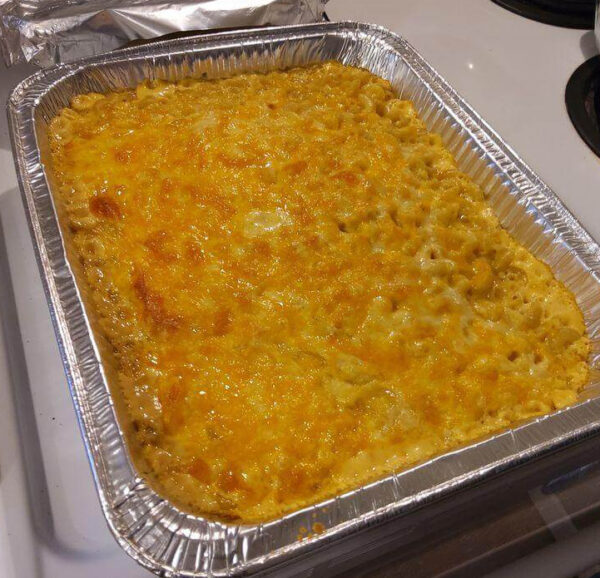
Ingredients
-
- 16 oz Elbow Macaroni
- 1 Cup of Whole Milk
- 3 Eggs
- 1 Stick of butter
- 8 oz of Colby Cheese – Shredded
- 8 oz of Sharp Cheddar Cheese – Shredded
- 1 lb of Velveeta Cheese – cut them up in cubes
- ½ cup of sour cream
- 1 tablespoon of ground black pepper
- 1 tablespoon of salt
- Topping: 1 Cup of Mild Cheddar Cheese – Shredded
Directions
-
- Preheat oven to 350 degrees
- Bring large pot of Salted water to a boil
- Cook elbow macaroni according to package instructions or until tender
- Mix both whole milk and evaporated milk and eggs in a large bowl, add sour cream, salt, and pepper
- Pour mixture of milk, eggs, sour cream, salt, and pepper over the macaroni
- Stir in the sharp, Colby, and Velveeta cheeses and butter
- Transfer the cooked pasta into a 10×14 oil-sprayed pan
- Sprinkle the top with one cup of mild cheddar cheese
- Bake for 45 Minutes or until the top is lightly browned
Matt Meacham, Program Manager, Statewide Engagement

One of the more distinctive recipes that I associate with my family is the dressing (or stuffing) that my grandma, Lorene Bollmann (1916-1997), made, and that my mom and my aunts still make at Thanksgiving. It combines savory ingredients (e.g., onions and celery) with sweet ingredients (e.g., raisins and cinnamon), resulting in something resembling a cross between the savory dressings served in many homes throughout the United States and bread pudding. That might sound a little unusual, but the proof, to paraphrase a familiar proverb, is in the dressing, which I find gustatorily captivating.
Ingredients
-
- 1 loaf of white bread, preferably homemade and slightly dried-out, torn into small pieces5 eggs, beaten
- ½ teaspoon poultry seasoning or sage
- ½ teaspoon cinnamon
- ¼ cup sugar
- 3 ½ cups chicken broth (Note for vegetarians: It’s possible that a high-quality vegetable broth would be an adequate substitute, but I
- haven’t tried it, so I can’t say for certain.)
- ¾ cup raisins
- ¼ cup chopped onion
- ½ cup chopped celery
- 1 ½ teaspoons salt
Directions
-
- Pour the beaten eggs over the torn-up bread and add the poultry seasoning or sage, cinnamon, and sugar.
- Add the chicken broth and stir. The resulting mixture should be approximately the consistency of soupy oatmeal.
- Add the raisins, onion, celery, and salt, and mix everything together.
- Place the mixture into a glass casserole dish and bake at 350 degrees for about 45 minutes.
The inspiration for this story comes from longtime Road Scholar Speaker Catherine Lambrecht, a culinary competition veteran who has traveled throughout Illinois with her Road Scholars presentation, “Family Heirloom Recipes from the Illinois State Fair.” Click here to learn more about the Road Scholars Speakers Bureau and the current cohort of presenters.